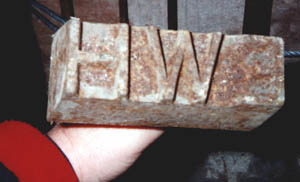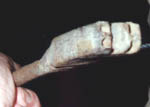Cattle and sheep
Cattle brands
 This big brand is heavy, because the head is solid iron. The cow would be fastened in
a "cattle crush" so she couldn't swing about. The brand was heated
in a fire (such as a brazier close by the crush). The size of the metal block ensured that the heat would last long enough to sear when it was pressed to the hide.
This big brand is heavy, because the head is solid iron. The cow would be fastened in
a "cattle crush" so she couldn't swing about. The brand was heated
in a fire (such as a brazier close by the crush). The size of the metal block ensured that the heat would last long enough to sear when it was pressed to the hide.
Cattle are less inclined to stray than sheep - they are not usually good jumpers of walls. So why did people brand cattle?
John Gate: "Oh yes, they had to brand them. Well there was this big share meadow; have you ever heard talk of "greedy gates"? All t’ stock that was to put on t' share meadow, had to go round by Town End Moor and ga through greedy gates, and they were branded.
"See, there was a herd to look them and all that, and they knew exactly whose they were acause of t' brand."
Horn burners
 These iron tools were used to mark the sheep so they were traceable if they strayed. John Gate recalls:
These iron tools were used to mark the sheep so they were traceable if they strayed. John Gate recalls:
"We used to make a fire in a bucket, drop them in and get them hot. Several of them, to use in turn while the others heated up."
Salving Sheep
Before the days of sheep dips, from the 16th century until the beginning of the 20th, it was a known practice in Cumbria to "salve" sheep with a mix of tar and rancid butter. This involved parting the fleece at regular intervals along the animal's side and smearing the mixture onto the skin with one finger. It was done from the middle of October to the middle of November and was supposed to kill off lice, keds, ticks and so on which would otherwise feed on the sheep's skin or suck blood from her. It was a long and smelly job and a man could only salve a dozen or so a day, so to deal with a big flock took weeks. His pay was 2 pence a day.
The recipe called for 16 lb of butter to 4 quarts of soft, "roany" tar which was an American import; this quantity salved between 35 and 40 sheep. It was expensive, costing 8d a sheep in 1868, whereas dipping, which came into use from around then, cost only 1½d. Kirkby Stephen farmers had their own recipe, using oil and tallow. Yet the habit seems to have died hard, even though salved wool sold less well than clean wool. Salved wool was still sold as late as 1890, when wool at Appleby was reported as selling at the following rates: "Half bred hogg, 8d to 9d; black-faced (salved) 4d to 4½d; black-faced (unsalved) 5d to 5½d per lb."
One of the first farmers to take to dipping his sheep was Mr Irving of Shap Abbey in 1850 who used "Biggs' Preparation" for his aged sheep and "McDougall's" for hoggs.
In 1905 due to an outbreak of sheep "scab", Government regulations began to compel farmers to dip sheep, and the ancient salve was completely replaced by the commercial soluble "dipping powders".
Tarry Wool
Tarry wool, oh tarry wool
Tarry wool is ill tae spin
Card it well, oh, card it well
Card it well ere ye begin (tune: MP3)
When it's carded, wove and spun,
Then your work is almost done
But when it's woven, dressed and cleaned,
It will be clothing for a queen